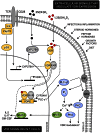The vitamin d receptor and T cell function
- PMID: 23785369
- PMCID: PMC3684798
- DOI: 10.3389/fimmu.2013.00148
The vitamin d receptor and T cell function
Abstract
The vitamin D receptor (VDR) is a nuclear, ligand-dependent transcription factor that in complex with hormonally active vitamin D, 1,25(OH)2D3, regulates the expression of more than 900 genes involved in a wide array of physiological functions. The impact of 1,25(OH)2D3-VDR signaling on immune function has been the focus of many recent studies as a link between 1,25(OH)2D3 and susceptibility to various infections and to development of a variety of inflammatory diseases has been suggested. It is also becoming increasingly clear that microbes slow down immune reactivity by dysregulating the VDR ultimately to increase their chance of survival. Immune modulatory therapies that enhance VDR expression and activity are therefore considered in the clinic today to a greater extent. As T cells are of great importance for both protective immunity and development of inflammatory diseases a variety of studies have been engaged investigating the impact of VDR expression in T cells and found that VDR expression and activity plays an important role in both T cell development, differentiation and effector function. In this review we will analyze current knowledge of VDR regulation and function in T cells and discuss its importance for immune activity.
Keywords: T cell function; activity; expression; signaling; vitamin D; vitamin D receptor.
Figures

References
LinkOut - more resources
Full Text Sources
Other Literature Sources
Research Materials

